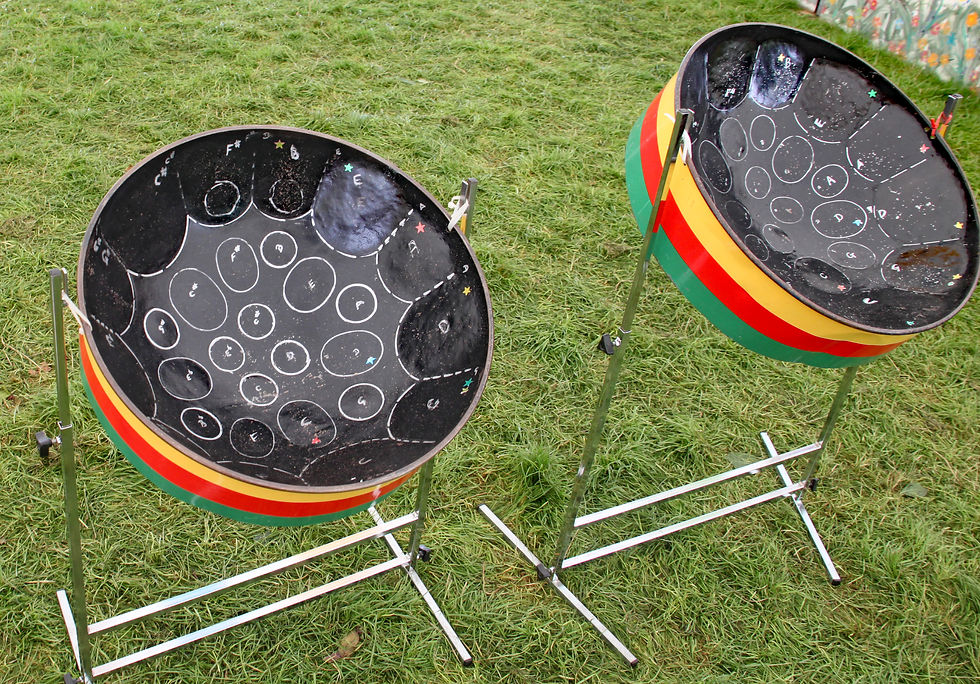Steel pan - the sweet sound of pan
- spiceisledigiconte
- Dec 2, 2022
- 3 min read
Updated: Jul 31, 2023
Steel pan music was started in the islands of Trinidad and Tobago. Steel pan is an example of a percussion musical instrument. This is the same category of musical instruments like the cuatro and banjo, other traditional musical instruments.
Steel pan was brought to Grenada by Grenadians who had worked and lived in Trinidad in the 1950s. One such Grenadian was William Dewsbury who pioneered the birth of steel pan in Grenada, and later became the Minister of Culture.

Instruments before Steel pan
The two main instruments used before the introduction of steel pan - the drum and tamboo bamboo. African drums were banned during the early years post emancipation. When drums were banned, tamboo bamboo became the replacement instrument. Tamboo bamboo used long bamboo sticks to make musical sounds by knocking the ends of the bamboo against the ground. Tamboo bamboo became widely accepted until 1935. It was banned thereafter.
The birth of Steel pan
Stee pan was introduced in 1955. Steel pans are made from used 55 gallon oil drums. The oil drums were dented or tuned to create the musical sounds "ping, pong, ping, pong". The oil drums are shaped into a bowl using hammers and air pressure. A tuner is a person who tunes the notes on the steel pan. Generally, steel pans have to be tuned either once or twice per year. Sticks tapped by rubber is used to create the pan sounds. The size of the rubber depends on the class of the pan being played.
There are different classes of pan:
Tenor
Double tenor
Triple tenor
Nine bass
The tenor has the sweetest sound, and the pan sticks have the smallest rubber. While the double tenor and triple tenor have deeper sounds, and the rubber on the pan sticks are thicker. The nine bass has the pan sticks with the thickest rubber.
Today, steel pans are still tuned in Trinidad and Tobago. Every year, steel pan orchestras in Grenada have to get their pans tuned in Trinidad.
Source: Now Grenada

Steel pan in Grenada
The first steel pan was the Hell Cats during the 1940s. The band was started by William Dewsbury who brought the idea from Trinidad.
According to A to Z Heritage by John Angus martin " The Hell Cats pounded drums with sticks wrapped with heavy black tape."
There were the Emmanuel brothers who lived in Cox Alley in St. George's who formed the orchestra called "The Coxipaters".
The Angel Harps steel band (now Republic Bank Angel Harps) was started in 1965 and has remained the band from the Carenage. The band moved to its current location in Tanteen in 1973.
The Commancheros is the second oldest band, started in 1967, by Denis Phillip. The band has remained the band from the St. Paul's Community.
The south of the Grenada has remained the parish with the most steel pan orchestras. There was at a time at least five bands including one at River Road, Grand Anse Valley, Carenage, St. Paul's and Town. In the early years, there was also a band from Belmont called Belmont South Stars.
Steel pans have also been part of rural community life. The Rainbow City All Stars is the steel pan orchestra from the big parish, St. Andrew's. There used to be a band in St. David's called the Corinth All stars for a few years in the 2000s. In the parish of St. John's, there are the Florida All stars and the Grand Roy Pan Angels.
In the sister isles, there used to be a steel pan orchestra in Carriacou. The band was called the Texaco Dixie Stars and was sponsored by the Oil Company in Trinidad, Texaco Oil. The band existed in the 1960s.
The parish of St. Mark had a steel band. The father of the calypsonian "Ello" (Elwin mark) named Mr. Rado captained a band in Victoria in the 1960s. There was the Sissons Syncopators which took part in Panorama Competition in the 1990s. The band was led by Michael 'Bokena' Darbeau.
In the parish of St. Patrick's, there was a steel band that was started at Macdonald College in 1990. It was the idea of Mr. Gordon Bolah at the time, a teacher of the school. The band went on to place 3rd in the National Junior Panorama Championship in the 1990's.
Here are videos of Steel pan music:
Copyrights to Commancheros.
Copyright to WSTglobalHD
Like and follow us on Facebook and Instagram to learn more about Grenada's history, heritage and culture.
Subscribe to our Youtube channel
Comments